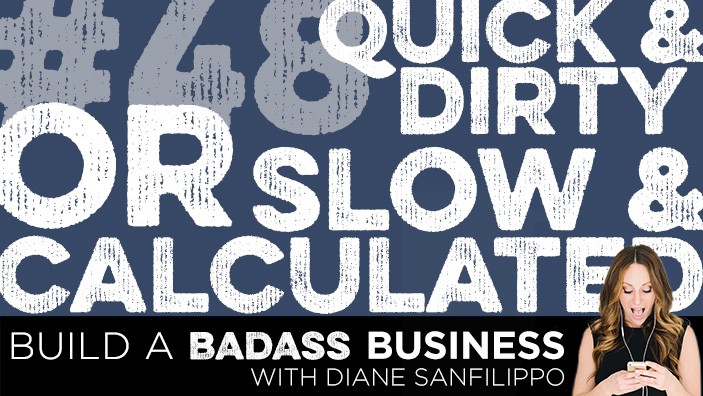
Build a Badass Business Podcast #48: Quick & Dirty or Slow & Calculated
 Topics:
Topics:
- You learn so much more exponentially when you’re taking a quick and dirty approach to something, because it forces you to figure things out.
- The value of the product that you’re selling really needs to speak almost for it.
Join the FaceBook group to get in on the conversation : Facebook, Build a Badass Business
And come follow me on Periscope! I’ve been posting videos often, and would love for you to hop on and interact with me, LIVE! Download the free Periscope app, then find me by searching “Diane Sanfilippo.” Replays available after at : Katch.Me
Don’t miss an episode!
Subscribe to Build a Badass Business on iTunes.
And don’t forget to leave a review once you’ve been listening!
Get your questions answered:
Fill out this quick form to submit a question to the show.


Build a Badass Business: Episode #48: Quick & Dirty or Slow & Calculated
Coming to you from the city by the bay, this is Build a Badass Business with Diane Sanfilippo. Diane is a New York Times bestselling author and serial entrepreneur. She’s here to teach you how to grow and develop a successful business you love, and how to create raving fans along the way. Here she is, your host: Diane Sanfilippo.
Diane Sanfilippo: Hey guys. Welcome back to another episode of Build a Badass Business. This week, I want to talk about two approaches to getting things done in your business, whether it’s a new project, a new approach to things, a new launch; anything that you’re creating or getting out there, there are two different ways we can approach things. One is quick and dirty; the other is slow and calculated.
I think most people fall in one camp or the other with the way that they tend to approach projects. Sometimes you’re forced into one or the other, even if it’s not what you prefer. And I think it’s important to know the value of both, as well as the drawbacks of both.
So let’s first look at the quick and dirty approach to getting things done, which I have to admit tends to be the way I approach things when it comes to an initial launch. However, I do think slow and calculated is important when it comes to something that will have a higher price tag, or you’re revamping or revitalizing or changing something that already exists.
If you’re trying to get things done in a quick and dirty way, this tends to mean that you don’t have as much money saved up, or you need to earn money faster. Right? Because you want this project to get done a lot faster, and presuming there’s a price tag attached to it, you want it done faster so that you can start earning money from it faster. This may cost you more money up front if you need to hire people, because if you need things done in a rush, or if you don’t have time to kind of vet people and find someone who may be able to do the job very well at a lower price, it may end up costing you more. However, the flip side of that is that it may end up being less expensive for you if you put the onus on yourself to figure more things out and almost put a little bit more stress and pressure on yourself to learn things and get them done on your own versus relying on a lot of people in an outside team.
So a downside to this can be that it’s messy; you may not have all your ducks in a row, so to speak. You may be sort of grasping at straws; you may be patching things together, just getting done what’s going to work. Again, that can be great because it’s the fast track, but in the wake of getting things done, you may look back and think; wow, that’s kind of a mess behind the scenes. But that may or may not matter to the people who are getting the end usable product or project, may look great as long as you don’t leave the mess on the outside. The mess could be behind the scenes.
Another drawback here to the quick and dirty approach is that you may make a lot of mistakes. So when I get into the slow and calculated approach, you’ll see that actually mistakes can be made either way. The nice thing about the quick and dirty approach is that you’ll probably figure out faster if you’ve made a mistake, because you’re trying to move at such a quick pace.
Downsides here are that it could cost you more, it could be messier, you could make more mistakes a lot more quickly. Now, the upsides here are that the entire project will take less time; which most of us want things done pretty quickly, especially in the age of the internet where we’re feeling like we’re always behind. There’s just this sense that everybody has that we just want everything done yesterday, we wish we had launched already. So this can take you a lot less time and help you get something out there faster.
Another upside is you do get the sort of forced learning, forced self-education/self-knowledge. So for example, you need to send out an email and you’re not quite sure how to use an email service, and you don’t have time or money to hire someone, you need to figure it out. You learn so much more exponentially, I find, when you’re taking a quick and dirty approach to something, because it forces you to figure things out that 11th hour, even when you’re trying to get something out there and you’re not sure why things are breaking. You put the pressure on yourself and you learn to figure things out. You also are able to trouble shoot things down the road, even if you are taking a slow and calculated approach; you have that arsenal of skill set that you can fall back on, because you’ve relied on yourself in the past to solve the problems, and now you know how to do it.
The other upside here, of course, is that you can earn money a lot sooner. So getting your project or product out there much sooner every day you wait to get something launched is potentially time that you’re not getting it into the hands of the people who want and need it, and of course then not exchanging that product or service for money.
Alright, a slow and calculated approach to things; this may cost you way less. When you go to hire someone to take on a project, of course if you have a rush on things it’s probably going to cost you more. Or it may cost you more because the first person that you hire, because you’re being hasty, isn’t a good fit, you end up hiring someone else, so that may end up costing you more. Whereas if you take things slowly and you’re more calculated, then you have time to vet someone to make sure they’re the right fit for the job.
The next upside to a slow and calculated approach is that things will just be neater. You’ll have a checklist, you’ll know exactly what needs to be done, you’ll feel like you’re moving in a particular order, you’ve gotten all your ducks in a row, everything is moving along as planned.
Another potential upside to being slow and calculated is fewer mistakes. I tend to think that mistakes can be made whether you’re moving quickly or slowly, and I personally think that moving quickly is a little bit more rewarding and more fun because you get to those mistakes faster and you get over them faster. If you’re moving very slowly, sometimes it takes you a long time to get to a mistake that later you figure out; if we had figured that out sooner, we could have solved a lot more problems a lot faster. But it is something that if you have a plan and you’re executing it in a very calculated way, you tend to eliminate some of the mistakes that could come down the road because you’re thinking things through a little bit more and just taking it at a slower pace.
So, the downsides of taking a slow and calculated approach are that you need more money; not necessarily to pay people involved in the project, but if you’re waiting on money that you will bring in from this project, then you need more money saved up essentially to just pay for things otherwise. So let’s just say that you are leaving a job, and you’re working on a new business or a new project, and you want to take it really slowly. You don’t want to be super risky, you don’t want to worry that you can’t pay the rent, pay the mortgage, pay the bills, buy your food; you need to have a lot more money saved up so you can take things slowly and not freak out that you don’t have money to pay for just the necessities in life.
The flip side of what I talked about with the quick and dirty approach here with slow and calculated is that there’s a little bit less forced learning, because you have a longer time frame, you don’t have as much pressure, so you may find yourself asking for a lot more help instead of putting that pressure on yourself to figure things out. So that will also then not only extend the time it takes, just inherently, but it will almost snowball extending the time, because you ask for help with one thing; it almost always opens a floodgate of other things you didn’t know about, and then you continue asking for more and more help, instead of saying; you know, let me just be really focused on this one project, this one little task I’m trying to get done figuring it out and moving on once you have figured it out on your own.
So there are upsides and downsides to both ways of doing things; I think that when you’re looking at launching a product or a program, I think the price point is really important to keep in mind. So if you’re going to release something that has a very high price point, a very high value to it, if it’s something that has a pretty narrow scope of an audience, which I think you guys have heard me talk before about the narrower the scope of the audience, generally the higher the price of the item you can charge.
So let’s just say you have a really specific tool for health coaches. The population of people who are health coaches is much smaller, for example, than the population of people who may be looking to jump into a sugar detox. So, when you have a smaller population of people or smaller demographic who are interested in what you have, you can charge a bit more.
So let’s say you’re creating a product or service for health coaches that will help them grow their business. You want this product to really deliver; you want it to be super valuable. It’s not something that you can put together in a quick and dirty way; you need to be calculated, you need to plan it out, you need to test things, you need to be proofreading really well, it needs to look really great. You can’t just throw it together.
Now, when I say “throw it together”, I don’t mean that it looks unprofessional, that on the outside someone thinks you’ve thrown it together. You know what I mean, the difference between something that you get done maybe in a week, two weeks or a month versus something that takes you two months, four months, six months, even a year to create. There is just an element of care and attention that goes into something that you spend a lot more time creating. But again, the price tag can definitely reflect that, not only in terms of the time you’ve spent, but the resources you’ve invested, and the value. The value of the product that you’re selling really needs to speak almost for itself. It should be a no brainer to someone that the price you’ve assigned to this product is making it well, well, well worth their investment.
Alright guys, I’d love to hear from you. Come talk to me over on the Facebook group or leave me a comment on Instagram, Periscope, wherever you want to come interact with me. What do you think; quick and dirty or slow and calculated approach? Do you tend to use one or the other more often? Do you find yourself falling back to one or the other when you’re not sure what to do? Which one do you think you’ve seen the most success with, and what would you recommend to somebody who has a new product or service to put out there?
Hey guys, I’m so glad you’re loving the show. Let me ask you to do me a favor; come follow me on Periscope. You can find me; I believe you can search Diane Sanfilippo, or you can search @BalancedBites, which is my Twitter handle, which is the account name over on Periscope. I am going to start doing live sessions, really quick thoughts for the day. I’m not sure if it I will be every day, but it will be pretty often, and some Q&A on business topics and motivation, inspiration, etc. So make sure you’re following me over on Periscope. Download the app in the app store, and I will see you there.
That’s all I’ve got for you guys today. Don’t forget to subscribe in iTunes so you don’t miss an episode. And drop me a review to let me know what’s speaking to you from the show. If you want to get in on the conversation and you haven’t yet joined the group already on Facebook, head on over there and join the Build a Badass Business group. I share insights and tips regularly, as well as answer your questions right there on the page. Do work that you love, and hustle to make your business grow like your life depends on it, because it does. Thanks for listening, and I’ll catch you on the next episode.


